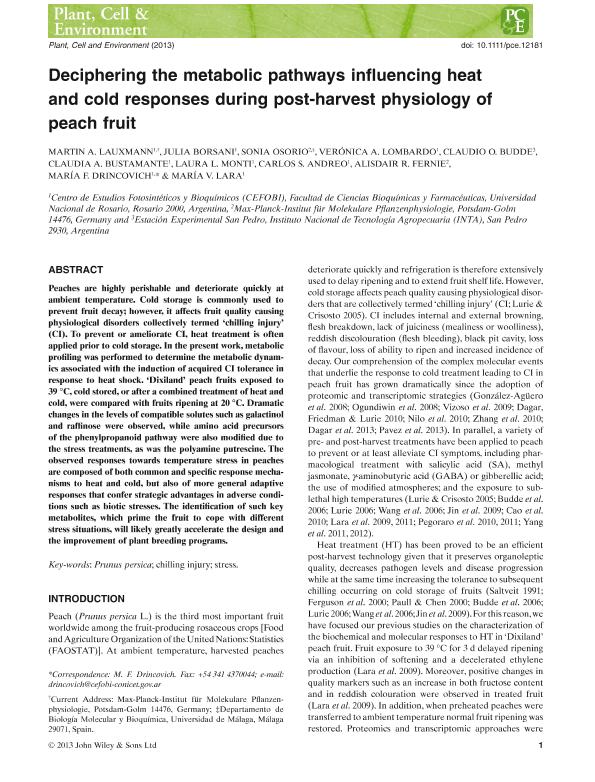Artículo
Deciphering the metabolic pathways influencing heat and cold responses during post-harvest physiology of peach fruit
Lauxmann, Martin Alexander ; Borsani, Julia
; Borsani, Julia ; Osorio, Sonia; Lombardo, Veronica Andrea
; Osorio, Sonia; Lombardo, Veronica Andrea ; Budde, Claudio O.; Bustamante, Claudia Anabel
; Budde, Claudio O.; Bustamante, Claudia Anabel ; Monti, Laura Lucía
; Monti, Laura Lucía ; Andreo, Carlos Santiago
; Andreo, Carlos Santiago ; Fernie, Alisdair R.; Drincovich, Maria Fabiana
; Fernie, Alisdair R.; Drincovich, Maria Fabiana ; Lara, Maria Valeria
; Lara, Maria Valeria
 ; Borsani, Julia
; Borsani, Julia ; Osorio, Sonia; Lombardo, Veronica Andrea
; Osorio, Sonia; Lombardo, Veronica Andrea ; Budde, Claudio O.; Bustamante, Claudia Anabel
; Budde, Claudio O.; Bustamante, Claudia Anabel ; Monti, Laura Lucía
; Monti, Laura Lucía ; Andreo, Carlos Santiago
; Andreo, Carlos Santiago ; Fernie, Alisdair R.; Drincovich, Maria Fabiana
; Fernie, Alisdair R.; Drincovich, Maria Fabiana ; Lara, Maria Valeria
; Lara, Maria Valeria
Fecha de publicación:
01/2014
Editorial:
Wiley
Revista:
Plant, Cell and Environment
ISSN:
1365-3040
Idioma:
Inglés
Tipo de recurso:
Artículo publicado
Clasificación temática:
Resumen
Peaches are highly perishable and deteriorate quickly at ambient temperature. Cold storage is commonly used to prevent fruit decay; however, it affects fruit quality causing physiological disorders collectively termed ‘chilling injury’ (CI). To prevent or ameliorate CI, heat treatment is often applied prior to cold storage. In the present work, metabolic profiling was performed to determine the metabolic dynamics associated with the induction of acquired CI tolerance in response to heat shock. ‘Dixiland’ peach fruits exposed to 39 °C, cold stored, or after a combined treatment of heat and cold, were compared with fruits ripening at 20 °C. Dramatic changes in the levels of compatible solutes such as galactinol and raffinose were observed, while amino acid precursors of the phenylpropanoid pathway were also modified due to the stress treatments, as was the polyamine putrescine. The observed responses towards temperature stress in peaches are composed of both common and specific response mechanisms to heat and cold, but also of more general adaptive responses that confer strategic advantages in adverse conditions such as biotic stresses. The identification of such key metabolites, which prime the fruit to cope with different stress situations, will likely greatly accelerate the design and the improvement of plant breeding programs.
Palabras clave:
Prunus Persica
,
Chilling Injury
,
Stress
Archivos asociados
Licencia
Identificadores
Colecciones
Articulos(CEFOBI)
Articulos de CENTRO DE EST.FOTOSINTETICOS Y BIOQUIMICOS (I)
Articulos de CENTRO DE EST.FOTOSINTETICOS Y BIOQUIMICOS (I)
Citación
Lauxmann, Martin Alexander; Borsani, Julia; Osorio, Sonia; Lombardo, Veronica Andrea; Budde, Claudio O.; et al.; Deciphering the metabolic pathways influencing heat and cold responses during post-harvest physiology of peach fruit; Wiley; Plant, Cell and Environment; 37; 3; 1-2014; 601-616
Compartir
Altmétricas



